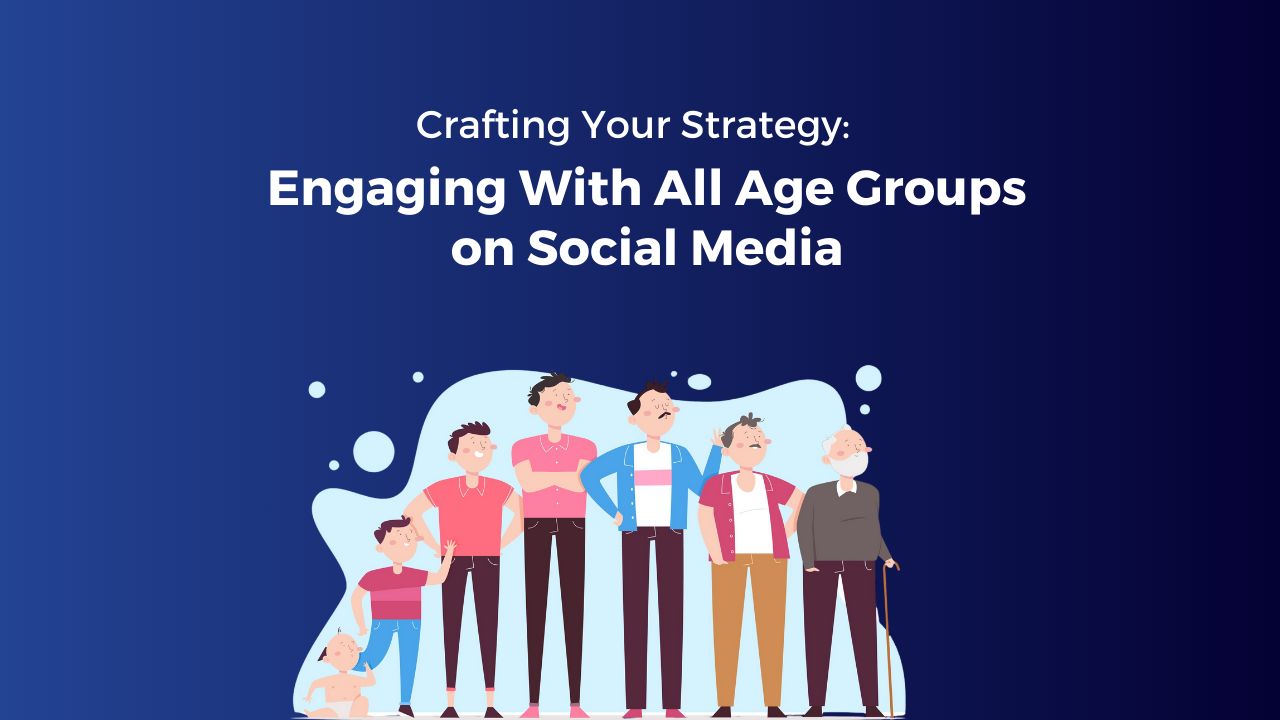Demographic data is a key building block in defining your target audiences on social media. Incorporating generational marketing insights into your strategies can greatly influence how people connect with your brand, from the awareness stage all the way to advocacy.
Building relationships across age demographics starts with an up-to-date understanding of how each generation interacts with social media networks and content.
What Exactly is Generational Marketing?
Generational marketing is a strategic method that involves dividing target audiences into age groups and tailoring marketing efforts to align with the values and experiences of each generational group. This approach doesn’t involve creating separate marketing strategies for each individual group (such as Baby Boomers, Millennials, and Generation Alpha), but rather adapting elements of existing strategies to resonate with the intended audience. Each generation is shaped by unique cultural, political, and digital trends, which influence their responses to marketing messages.
Why Tailoring your Marketing Strategy is Important?
Will every individual born within a particular fifteen-to-twenty-year timeframe exhibit identical interests, hobbies, or purchasing behaviors? Certainly not. Despite the fact that they are not all the same, generational groups can provide marketers with insightful information. This is the reason why:
They contribute to a more impactful market message
Have you ever encountered a marketing campaign that seemed tailor-made for you? Chances are, every aspect of that campaign was shaped by extensive data analysis, including research specific to different generations. These insights let marketing teams understand what will resonate with their intended audience, from design choices to cultural references. Generational marketing strategies empower brands to craft distinct messages that directly address the values, preferences, and experiences of each generation. They foster genuine connections that inspire and foster brand loyalty.
They ensure brands stay relevant
As time progresses, individuals in your target audience age and new generations emerge as potential consumers. These emerging generations bring with them unique experiences that shape their interests and preferences, often differing significantly from those of previous generations. While age demographic data may not form the foundation of your strategy, it can help ensure your messaging evolves in line with the evolving expectations of your target consumers. By doing so, you secure your brand’s ongoing relevance and resonance with your audience.
They help with market expansion
Generational marketing strategies not only assist your brand in maintaining relevance with its existing target audience but also offer a structured approach to reach entirely new age demographics. This data acts as a foundation for informed experimentation, helping you to develop targeted marketing initiatives that ultimately help you pinpoint what resonates most with your emerging user demographic.
What are the Steps Towards Generational Marketing?
1. Understanding your audience
Prior to crafting any content, it’s crucial to have a clear understanding of who your audience is and what they expect from you. Conduct thorough research on your target demographic, segmenting them based on factors such as age, interests, objectives, and obstacles. Leverage tools like Google Analytics, Facebook Insights, or Linkedin Analytics to gather data on their demographics, behavior patterns, and engagement levels. Additionally, utilize surveys, polls, or interviews to directly gather feedback and insights from your audience. This deep understanding of your audience will let you customize your content to cater to their specific needs, preferences, and pain points.
2. Selecting the right platforms
It’s essential to recognize that not all social media platforms hold the same level of popularity or effectiveness across various age groups. It’s crucial to opt for platforms that align with your audience’s preferences and behaviors. For instance, younger demographics often favor visually engaging and interactive platforms such as Instagram, TikTok, or Snapchat, whereas older age groups lean towards more text-based and informative platforms like Facebook, LinkedIn, or Twitter. Additionally, it’s important to consider the intended purpose and tone of each platform. For instance, LinkedIn typically maintains a more formal and professional atmosphere, while Instagram fosters a more casual and creative environment. Adapting your content to match the style and audience of each platform is essential for maximizing engagement and resonance.
3. Make Use of Various Formats
Various age demographics exhibit distinct preferences for different content formats, based on their learning styles, attention spans, and emotional responses. It’s essential to employ a range of formats to cater to these preferences. For instance, younger generations typically gravitate towards short, engaging, and entertaining content such as videos, stories, or memes. Conversely, older age groups often favor longer, informative, and educational formats like blogs, podcasts, or webinars. Repurposing content into different formats can also broaden your reach. For instance, transforming a blog post into a video, a podcast into a graphic, or a webinar into a series of tweets enables you to engage with a wider audience across various platforms.
4. Deliver value and resonance
Regardless of the age range you are targeting, you must create content that resonates with and adds value to your audience. Demonstrate how your content can assist them in resolving their issues, attaining their objectives, or meeting their interests. Additionally, ensure your content matches their context and circumstances. Take into account the current trends, events, and challenges impacting your audience, and craft content that reflects these aspects. Incorporating hashtags, keywords, or mentions can also enhance the visibility and relevance of your content, further engaging your audience.
5. Foster engagement and interaction
Social media presents a valuable opportunity to directly engage and communicate with your audience. Seize this chance to build trust, loyalty, and relationships with your audience members. Engage and interact with them by posing questions, addressing comments, seeking feedback, sharing user-generated content, or hosting live sessions. It’s essential to maintain an atmosphere of respect, authenticity, and empathy when interacting with individuals from different age groups. Avoid using jargon, slang, or humor that may bewilder, offend, or isolate your audience, ensuring meaningful and inclusive interactions.
6. Experiment and refine
Ultimately, it’s crucial to experiment with and refine your content to make sure it works across various age groups. Measure and analyze your content’s performance and impact using metrics such as reach, impressions, clicks, likes, shares, comments, or conversions. Additionally, employ tools like A/B testing, split testing, or multivariate testing to compare different iterations of your content and determine which resonates most effectively. Utilize the insights gained from testing and optimizing to enhance your content further, making it more engaging and impactful.
Understanding Gen Z’s Social Media Usage
Generation Z, often referred to as “Gen Z” or “Zoomers,” is deeply involved e in the digital world. Many of these digital natives have maintained a social media presence for over half of their lives. Research suggests that Gen Z’s engagement with social media is only expected to escalate. A significant 41% of Gen Z consumers anticipate increasing their usage of social networks in 2024.
Contrary to expectations, Gen Z’s social media activity isn’t solely confined to emerging platforms; they’re also making an impact on established platforms. Take LinkedIn, for instance. According to an interview with The Cut, LinkedIn Career Expert Andrew McCaskill revealed that Gen Z is one of the fastest-growing demographics on the platform. This surge in participation has contributed to a remarkable 41% increase in content posted on LinkedIn between spring 2021 and spring 2023.
Expectations of Gen Z from Brands on Social Media
Although Gen Z is very interested in interacting with brands in ways that go beyond simple purchases, they prioritize customer-centric experiences. Approaches that prioritize direct engagement are more desirable than those that prioritize the sheer amount of content.
Furthermore, Gen Z shows a heightened level of caution towards brands using AI in social interactions, distinguishing them from their Millennial and Gen X counterparts. Their main concerns are related to possible negative effects, such as decreased authenticity, weaker customer service, and less interpersonal engagement.
Strategies for Reaching More Gen Z Consumers on Social Media
To effectively target Gen Z, prioritize social content that fosters two-way interactions and encourages engagement in relevant discussions. Begin by evaluating your existing strategy through the lens of customer experience. Here are some questions to guide your assessment:
– Does your awareness content stimulate engagement, such as polls, user-generated content, quizzes, etc.?
– How promptly does your team typically respond to questions or comments?
– To what extent do customer insights and data currently shape your content strategy?
If customer feedback hasn’t been central to your strategy, consider its potential impact on your brand. Experiment with new content at least twice a week, and assess its performance relative to your standard social content.
Understanding Millennials’ Social Media Habits
Millennials frequently struggle with out-of-date ideas that come from their early days on social media and don’t fully reflect who they are now. Many are navigating the complexities of adulthood, grappling with the mix of excitement and uncertainty that accompanies milestones such as career advancements, parenthood, and eldercare responsibilities. A significant 72% of Millennials regard social media as an integral aspect of their lives, marking the highest proportion across all age groups.
Despite their hectic schedules, Millennials exhibit a willingness to explore new platforms. Interestingly, they use Threads extensively; nearly half (42%) interact with Meta Threads every day, and 36% do so once a week.
Meeting Millennials’ Expectations from Brands on Social Media
To effectively engage with Millennials, only relying on meme templates and trending audio won’t work. Similar to their Gen Z counterparts, Millennials value brands that prioritize customer responsiveness. However, they place greater emphasis on brands creating original content rather than direct engagement.
If the thought of generating more content feels overwhelming, don’t worry. Instead, consider avenues for building online communities centered around your product or service. This approach offers a mutually beneficial outcome: your followers find support and connection, while your brand gains a steady stream of highly relevant content ideas.
Expanding Your Business’s Reach to Millennial Consumers on Social Media
Building a vibrant social media community is not a one-size-fits-all task. But for it to succeed, a few basic actions are essential.
Start by pinpointing the purpose of your community. Conversations centered solely on your product or service may become repetitive over time, so broaden your perspective. Associate your brand with broader topics that foster sustained discussions.
Utilize social listening tools to uncover broader topics of interest relevant to your brand. Analyze ongoing conversations among your followers, competitors, and the industry as a whole. Once you’ve identified common themes, leverage this insight to create a community-specific content strategy that encourages continuous engagement.
Understanding Baby Boomer’s Social Media Usage
While the majority of Baby Boomers intend to maintain their current level of social media usage in 2024, only a small percentage anticipate increasing or decreasing their usage. Although this generational group initially embraced social media at a slower pace, they have since become active participants on established platforms. Facebook remains their most utilized social platform, followed by YouTube and Instagram. In contrast, adoption rates for newer platforms like Threads among Baby Boomers are notably lower.
Understanding Baby Boomers’ Expectations from Brands on Social Media
Although Boomers and older adults belong to different age groups, they have similar expectations when it comes to social media interactions with brands.
Thirty-five percent of Baby Boomers use social media to explore and discover new brands, while 48% view social platforms as avenues for interacting with brands and companies online. Although Boomers are less inclined to create profiles on emerging social networks, they are nevertheless open to new forms of advertising on the ones they already use.
Expanding Your Business’s Reach to Baby Boomer Consumers on Social Media
If Baby Boomers constitute a significant portion of your target audience, tailor your platform strategy based on the most impactful channels for engaging with this demographic.
Final Thoughts
Understanding and incorporating generational marketing insights into your social media strategy is essential for effectively connecting with diverse age groups. Each generation responds differently to social media platforms and content, necessitating tailored approaches. Leveraging social listening tools, experimenting with various content formats, and fostering engagement are key strategies for reaching and connecting with audiences across different age groups. Tailoring your platform strategy based on audience preferences and behaviors ensures maximum impact and resonance, ultimately leading to successful engagement and brand growth.



